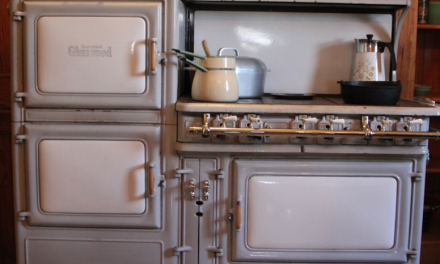It’s hard to believe there once was a time in America when fondue was cool…or, at least, taken seriously. Somewhere along the way, fondue became a punchline, a joke involving turtlenecks and horrible mustaches. It’s too bad, really. That tired comedy keeps far too many people from enjoying a most satisfying and communal meal with a fascinating history.
Fondue has always been strongly associated with the Swiss, although other neighboring nations enjoy similar recipes. Originally considered a low-country peasant dish, the perception of Swiss fondue evolved over time into a cultural identifier. In the 1930s, The Swiss Cheese Union marketed fondue as a national dish to help increase cheese consumption, creating regional recipes to “spiritually defend” the homeland. That came to a temporary halt during World War II when rationing went into effect. Since the end of the war, fondue has been a symbol of Swiss community and cuisine.
When considering the history of fondue, a distinction between the name and the dish is needed. The concept of melting cheese in wine is an old one. The earliest written evidence is found in Homer’s 8th century Iliad, in which goat cheese and flour is mixed with warm wine. The first known recipe came in the 17th-century Swiss cookbook Kochbuch written by Anna Margaretha Gessner. She provided a recipe called “Käss mit Wein zu kochen,” which translates as “to cook cheese with wine.” This recipe blended grated cheese with hot wine, into which stale bread is dipped.
The name “fondue” comes from the French verb fondré (“to melt”) and doesn’t appear until 1735, when French chef Vincent la Chappelle’s cookbook Cuisinier Moderne presented the recipe “Fonduë de Fromage, aux Truffes Fraiches,” The recipe called for melted cheese and wine to be combined with eggs and truffles, resulting in a texture somewhere between runny scrambled eggs and a soufflé. Finally, in 1875 a recipe was published that is virtually the recipe followed today: rub a pot with garlic, heat the wine, melt grated cheese and dip stuff into it.
In America, the term fondue dates back to the 1930s but represented a chocolate mousse or torte. In the 1950s, Swiss restaurateur Konrad Egli introduced fondue bourguignonne to diners, but it wasn’t until the Swiss pavilion served traditional fondue at the World’s Fair of 1964 in New York that Americans got their first taste of the good stuff. The real stuff. While fondue enjoyed a huge following in the 1960s and the early 1970s, it then gave way to other culinary trends and the wisecracking began.
There are many, many ways to enjoy a pot of molten cheese. In Neuchâtel, classic is king–equal parts Gruyère and Emmental cheeses. Head southeast to Fribourg and dine on moitié-moitié (half and half ), a blend of Gruyère and locally produced Vacherin cheeses. Head farther south and dip into a gooey blend of cheese, wine, and tomatoes. Leave Switzerland, and encounter regional variations in France and Italy. All just as simple. All just as delicious.
There are plenty of great local options for fondue cheeses. In our feature recipe we used Massachusetts Appleton Farm’s Pinnacle and Robinson’s Farm Family Swiss cheeses for a classic combination. Expand the search to New England, and the options abound! Springbrook Farm in Vermont, Landaff Creamery’s eponymous cheese in New Hampshire, Cato Corner Farm’s stinky Hooligan in Connecticut…the list goes on and on.

A basic fondue is a combination of cheeses and wine. It is cooked in a broad glazed earthenware pot called a caquelon. First, the inside of the caquelon is rubbed all over with raw garlic. White wine is heated with a bit of cornstarch to thicken and smooth out the emulsion as the cheese melts, then grated cheese is incorporated and melted. Finally, a splash of kirschwasser (cherry brandy) is floated on top. Diners use tiny, elongated forks to dip stale bread, veggies, charcuterie…whatever is at hand. While traditionalists consider it polite to use the fondue fork to transport the dipped food to your plate, modern etiquette allows for the faster pot-to-mouth route, especially amongst friends—although the “single-dip only” rule is strictly followed.
When enjoying a fondue, adherence to Swiss customs is highly encouraged. For example, should a gentleman find his morsel has sunk into the fondue pot, he is expected to buy a round for the table. And for Lady butterfingers? A kiss to each neighbor mitigates any embarrassment that might be experienced. Swiss fondue etiquette also calls for a midi-boire (“mid-drink”), a chilled shot of the cherry brandy halfway through the meal. (I wholly encourage that one.)
Once the molten cheese has been consumed, a crust will likely have formed on the bottom of the pot. Under no circumstances should that be thrown away! That is la religieuse (French for “the nun”) and the crust can be lifted out and eaten, with a texture similar to a wafer or cracker. If your evening has a guest of honor, they are offered la religieuse as a sign of gratitude for their attendance.
Fondue is a casual and communal way to share a meal with friends and family. It’s easy to make, beyond delicious, and when it comes right down to it, rather classy. This winter, chill some bottles of crisp white wine, invite some friends over, and melt up a fondue or two. Turtlenecks optional.
Adam Centamore, when not conducting wine and cheese tasting “research” for his next book or eating heroic quantities of escargots swimming in butter, this educator and author can be found pursuing his goal of having a sandwich named after him in every time zone.
Neuchâtel-Style Fondue Recipe is here







